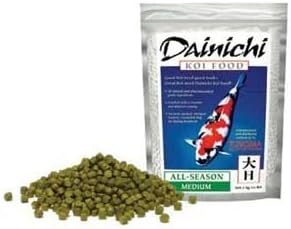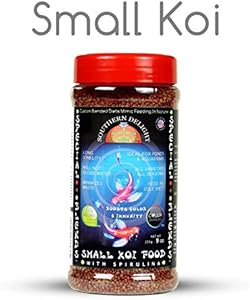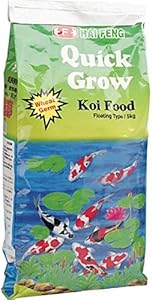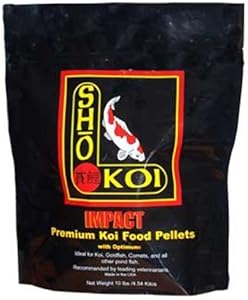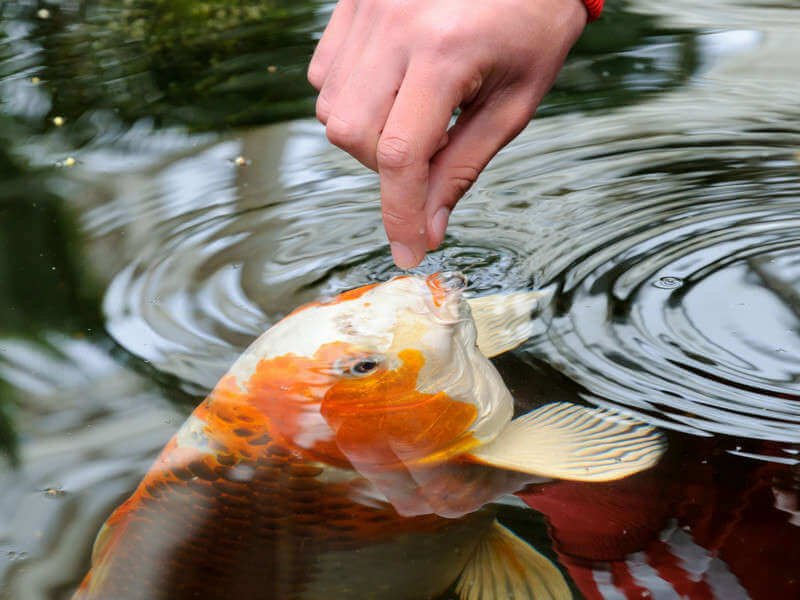Koi are colored varieties of Amur carp (Cyprinus rubrofuscus). The correct Japanese term is nishikigoi, which means “brocaded carp”. The name was first used as far back as 200 years ago in a village from the Niigata prefecture in Japan.
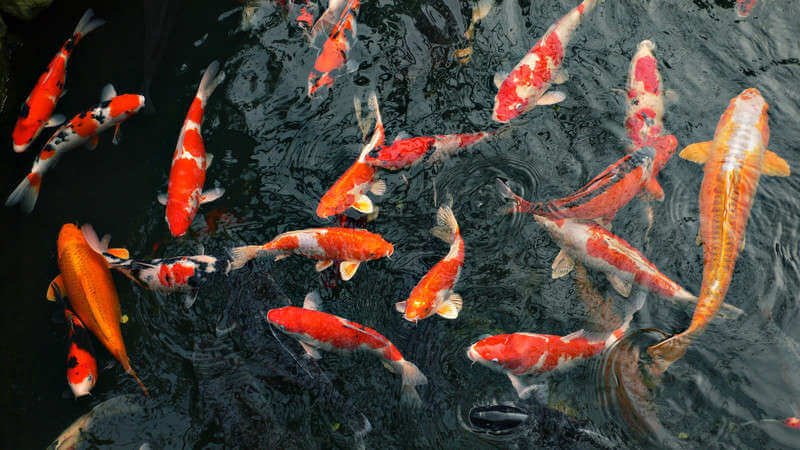
Koi are loved even by people with no interest in keeping the fish. Their beautiful colors and friendly nature have captivated people around the world. Koi can live up to 35 years on average, some even longer. Koi require proper care to thrive and remain healthy throughout their long lifespan. Good nutrition is key to developing a balanced body shape, strong fins structure and bright coloration.
The quality of food you feed to your koi also determines their resistance to disease problems. We’ll explain how to pick a good koi food, then get a brief lesson on where the fish we know as koi came from.
In this article
Best Rated Koi Foods Reviews
1. Hikari Floating Pellets for Koi and Pond Fish
Hikari is a Japanese fish food company, well-known for producing specialty koi food.
Hikari Koi Gold is a 35% protein, color-enhancing daily feed for all types of koi. The floating pellets are formulated for feeding Koi in warmer water temperatures. The ingredients promote color enhancement while the vitamin and minerals support immune system health.
Hikari Staple contains 34% protein. The balanced ingredients support fast growth, proper form and efficient nutrient utilization. This staple diet contains necessary vitamins, including stabilized vitamin C to support immune system health.
Saki-Hikari Growth is a professional growth pellet for maximizing the size of champion koi. Hikari developed a special blend of lipids and other necessary nutritional components that reduce the chances of internal fat deposits which can form when pushing fish to grow quickly with a 40% protein feed.
2. Dainichi
Dainichi koi food are produced the United States. The company minimizes the use of starch to provide a dense, nutrient-packet pellet.
Dainichi Premium (42% protein) contains five sources of protein, including spirulina, krill, and shrimp that act as color enhancers. Dainichi’s contains a blend of vitamins and minerals, especially vitamins C & E for luster, sheen and bright whites.
Premium contains calcium montmorillonite clay to simulate the natural ingestion of minerals.
All-Season floating pellets (39% protein) are for year-round feeding. Ingredients include marine and vegetable proteins for rapid growth, and plant-based materials for easy digestion in all temperatures. Shrimp and spirulina help in maintaining vibrant colors of all koi varieties. Dainichi foods are available in small, medium and large pellets.
Dainichi also have koi foods for growth and color.
3. Southern Delight
Southern Delight Fish Foods is a US-based company that manufactures a variety of aquarium and koi foods.
Small Koi Food is a 1.5 mm slow-sinking pellet. It is actually a blend of their Color-Pellets and Nutri-pellets. Color-Pellets contain salmon, herring and wheat meal along with color enhancing beta-carotene, algae meal and shrimp meal. Nutri-Pellets contain essential vitamins and minerals along with vegetable meal, alfalfa meal, wheat flour and fish meal.
The small-sized pellets are ideal for young koi.
4. Hai Feng Feeds Company
Hai Feng is located in Taiwan. Quick Grow Koi Food contains wheat germ, fish meal, vitamins and organic minerals. The food can be used even in cool weather. Other ingredients include shrimp meal, spirulina, soybean mea, and, brewers dried yeast.
Quick Grow is 32% protein. The floating M-L pellet -is approximately 3/16″ and the floating Large Pellet is approximately 5/16″.
5. Kaytee
Kaytee is a major manufacturer of pet foods. The Koi’s Choice is an all-season floating pellet.
The 5-mm pellet contains Fish Meal, Ground Corn, Dehulled Soybean Meal, Wheat Flour, Corn Gluten Meal along with vitamins and minerals. The 35% protein food contains mainly plant-based ingredients.
6. Sho Koi
Sho Koi feeds are manufactured in the United States. The main ingredients in this large floating pellet are wheat, hydrolyzed feather meal, anchovy fish meal, soybean meal, fish oil and alfalfa meal. The formula is fortified with vitamins and minerals.
Sho Koi is a 38% protein food that can be fed all year round. The food is packaged in several small bags and placed in a single retail bag. This makes it easier to maintain freshness by only opening one bag at a time.
7. Aqua Master
Aqua Master fish foods are produced by Uni-President Enterprises Corp of China. Aqua Master Color Enhancer pellets contain Fish Meal, Krill Meal and Wheat Germ.
The 7-mm pellets are coated with Bacillus bacteria spores. These bacteria help break down organic debris in the pond. The formula also contains Spirulina and Astaxanthin for color enhancement.
The history of koi
The history of koi is unclear. There are several stories that have been handed down over the years.
It seems that the original koi did not come from Japan. The best accounts say the fish are from eastern Asia, in the Black, Caspian, Aral Seas and China. Chinese farmers raised carp in ponds and rice fields for food. The black carp (Magoi) was a food fish raised as a protein source for the winter months.
Color mutations appeared in some of the carp in the early 1800s. Fish farmers noticed red, white and pale-yellow colors on the wild fish. By the mid-1800s, cross-breeding of red and white carp produced what is believed to be the first Kohaku.
Koi varieties such as Asagi, Higoi and Bekko, continued to be cross-bred, genetically locking in their colorful traits. Breeding continued to develop new color types. Today there are at least 24 varieties of koi.
The biology of koi
Koi have what is called a “fusiform” shape. This means their body tapers at the head and tail. Unlike goldfish, their mouth points downward.
Koi do not have a stomach. This means koi cannot store a meal in a stomach.
Here’s how koi eat and digest their food. When a koi opens its mouth to eat, a suction is created, pulling in the food and some water. The water is pumped out through the gills. The food is moved to the back of the mouth.
Once there, it is ground up by hard tooth-like structures called pharyngeal teeth.
Koi don’t swallow their food whole. It’s chewed into smaller pieces first. The food is then swallowed. But instead of going into the stomach for digestion, it makes a long trip through the koi’s unique digestive system.
The food travels through the fish’s long intestinal tract. It can be about three times as long as an adult koi’s length. In younger koi the tract is shorter, only about the length of the fish.
How koi digest food
As food moves through the intestines, digestive juices break down the food so it can be absorbed.
The walls of the intestines are lined with tiny finger-like projections that increase surface area help absorb the nutrients. The intestines also release mucus which lets the food move through the fish.
There are a variety of beneficial bacteria that live in the fish’s gut. These bacteria help break down the food so the fish can easily absorb the vitamins, minerals and other forms of nutrition in the food.
Koi have a good sense of taste and smell
One of the interesting things about koi is their inquisitive nature.
They’re always exploring the bottom of the pond, plants and ever surface of the water. That’s because they have a great sense of taste and smell. Even if they can’t see the food, they can smell it.
Like radar, koi can narrow down the location of food by smell, then taste it to see if it is something good to eat.
Koi have taste buds around their lips, mouth and on the barbels.
What do koi eat?
Koi are omnivores. That means they’ll eat everything including worms, insect larvae, small fish, eggs, algae and plant fragments.
Koi, like wild carp, forage continuously on the bottom, looking for food through taste, touch and smell. You’ll often see them sucking algae and other floating foods from the water surface. Koi will scrape off algae and bacteria from the surface of plants and rocks too.
But nature can’t always supply enough of the foods koi need when living in a backyard pond. That’s where commercial fish foods come into the picture. Fish food manufacturers formulate special diets just for koi kept in man-made ponds.
Prepared koi foods
Koi are the king of the ornamental fish pond.
While all koi are loved by their care takers, some fish are so rare that they’re worth thousands of dollars. Specialty koi food manufacturers have created a variety of foods for every life stage. You can purchase a 3-inch juvenile fish or fully mature koi over one foot long.
Koi foods come in a wide range of pellet sizes. Very small pellets are for baby koi. Larger koi enjoy big pellets. The idea is to match the pellet size to the fish. Koi like to be able to bring the pellet to their grinding teeth.
If the pellet is too large, it makes it difficult or impossible for the fish to chew. Small pellets are eaten by even the largest fish, but they seem to like the feel of a pellet that fills their mouth and can be easily tasted and chewed up.
Sinking or floating pellets?
Sinking pellets fall right to the bottom of the pond. Koi will forage along the pond bottom, easily detecting the pellets scent and flavor.
Since koi have a mouth designed for bottom feeding, it is very natural for them to feed on sinking pellets. But koi are smart and enjoy coming to the surface for food.
Floating pellets allow you to see your fish come to the surface. Big fish will rise right out of the water in search of the floating pellets. They’ll feed from your hand. You’ll also find floating stick food too.
Koi will grind down the stick as they chew it up and swallow. Floating pellets make it easy to see how much food your adding to the pond. Skilled koi-keepers measure sinking food. That way they don’t over-feed. It’s ok to feed both kinds of pellets.
Understanding koi food ingredients
Koi food manufacturers create food recipes to provide protein, fat, vitamins and minerals at levels that sustain growth and health. Koi foods are subject to nutritional regulations and requirements.
All food ingredients must be approved by government feed agencies if they are mentioned on the label. Food manufacturers must use ingredients from an official list of food ingredients. Only koi foods that meet these requirements can be labeled as a “complete and balanced” diet.
You’ll also notice that the label shows the food contains supplemental vitamins and minerals. The koi food is fortified to ensure the right amount of trace elements, vitamins and minerals are in each pellet.
The first few ingredients on a food label are the protein sources. These may be animal or plant-based ingredients.
Research has shown that a protein level of about 32% is enough to maintaining normal growth and vitality.
Most koi farms don’t use specialty koi foods to raise their koi. It would be very expensive.
Fish farmers use generic food pellets that use basic ingredients and a balanced formula of protein, fat, vitamins and minerals. But fish farms are usually raising fish in outdoor mud-bottom ponds. These natural ponds have much more live foods for the koi to feed on.
Is fish meal better than grain?
There is some controversy about which type of ingredients are best for koi.
Fish meal, a major source of protein, contains the most complete amino acid balance. It’s also quite expensive. Fish meal is made from marine fish like herring, sardines and tuna.
Fish meal, by food standards, is not fit for human consumption but can be included in fish foods. Whole fish are cooked, dried and ground into meal.
You may see “whole fish” on the ingredient lists. There is no official definition of “whole fish” or “fish meal” by government feed officials. Even if top-grade fish is being used, the fillets must be processed into a fine meal to work in the pelleting process.
In aquaculture, there is also a trend to use plant-based protein sources to reduce the harvesting of wild-caught fish.
Corn meal is a low-cost protein substitute associated with poor-quality fish food.
Wheat, soybean and yeast-based meals are digestible by the fish and a common source of nutrition.
Some koi enthusiasts view grain as cheap protein substitutes, but university research shows that many plant-based formulas work quite well.
Other ingredients include blackfly meal, algae and, mussel meal as nutritional sources. Fish oil is blended in to add essential fatty acids. It is an energy source for the fish. Typical levels are 7-15%.
The ingredient list will also include vitamins and minerals, which are necessary for a complete and balanced koi diet.
Fish food gets it color from the ingredients. Some use natural colors like annatto extract. You may see artificial dyes like Red 3.
Fiber adds no nutritional value. Typical levels range from 4-6%.
Watch the density!
Starch is used in pellets and sticks to manage the density and give floating pellets buoyancy. More starch puffs up the pellet with air, so it floats.
High-quality floating pellets use just enough starch to keep the pellets afloat.
But it’s also possible to add a lot of cheap starch as filler. When you see a big container of koi food that weighs almost nothing, you know it is mostly starch and air. You’ll have to feed more to satisfy the fish.
Denser, heavier foods have less airspace. They’ll cost more but you can feed less at each feeding. That’s because each pellet is packed with nutrition, not air.
Color enhancing foods
Koi kept in algae-rich ponds with plenty of sunlight develop vibrant colors. Experts say it is a combination of live foods and sunlight that stimulate the beautiful, bright color patterns.
Some specialty koi foods include natural color-enhancing ingredients like marigold petals, pepper meal, chlorella algae and krill.
These ingredients contain carotenoids. These are fat-soluble pigments that give koi their red, orange and yellow colors.
Koi can’t make their own carotenoids; they have to come from their food.
You may also see astaxanthin on the ingredient list. This natural carotenoid is used in aquaculture to give food fish like salmon pink flesh. It will enhance koi color too.
Fresh and frozen koi foods
There are a lot of foods you can prepare yourself that are safe and a nutritious treat for koi.
Boiled rice or pasta are favorite treats. After cooking, rinse off the sticky starch. You can store uneaten food in the refrigerator.
Pieces of whole wheat bread with oatmeal is another favorite. You can even spread a little honey on the bread. Koi will literally jump out of the water for a piece of this tasty whole-grain goodness. Slice up a hard-boiled egg and hand-feed it to your fish.
Koi love fresh fruit and vegetables. They’re rich in fiber, vitamins, trace elements and antioxidants. Koi enjoy the texture, taste and smell of fresh fruits and veggies. Toss in a wedge of lettuce and watch your fish tear it to pieces. Throw in orange slices. The koi will have a blast sucking out the pulpy juice. Don’t be afraid to try other fruits and vegetables.
Raw peas, beans and corn are harder to digest and should be avoided.
How to feed koi
When Koi aren’t basking in the sun they’re foraging for food. Since koi don’t have a stomach, several small feedings per day are recommended.
Koi enthusiasts who want their fish to grow quickly feed much more often than a typical backyard pond-keeper.
Most people feed once in the morning and once at the evening.
Many koi enthusiasts prefer floating pellets because it makes it easier to see the fish. Sinking pellets are fed too, but usually alternating between floating and sinking types.
Stick foods are not as popular but offer koi variety. Use fruits and vegetables as a treat.
Be aware uneaten food will eventually rot and pollute the pond water.
Pellets should be consumed in about ten minutes. Fresh fruits and vegetables can float for the entire day.
If you routinely find uneaten pellets, it’s a sign your adding too much food at one time. Cut back on the number of pellets and see if the fish eat them all.
Problems with over-feeding
Koi will always come to the water surface when they see you approach the pond.
Koi are very social and want your attention. They know you give them food every day. This behavior is normal but doesn’t mean the fish are hungry.
Stick to a feeding routine and don’t over-feed.
Here are a few of the problems pond-keepers face when they add too much food:
- Toxic pond water: Uneaten food causes harmful ammonia and nitrite build-up,
- Algae growth: Uneaten food releases algae-promoting nutrients into the water,
- Sludge build-up: uneaten foods falls to the bottom, forming a sludge layer,
- Disease outbreaks: A dirty pond is the perfect environment for fish pathogens,
- Obese koi: Over-feeding can cause obesity and stress the heart.
What if your koi won’t eat?
A stressed koi may stop eating. If the fish is new to the pond, give it a few days to acclimate.
Test the pH, ammonia and nitrite levels to make sure the water is safe.
Switching food can also cause koi to temporarily stop feeding. Sometimes it’s helpful to gradually change to another food.
Check your fish for signs of disease. External parasites will weaken and stress the fish.
Vacations and koi feeding
It’s quite OK to leave the fish for a day or two. They’ll forage for live foods until you return.
But what to do when you are away on a vacation or extended trip?
If you’ve got a reliable neighbor or relative, teach them how to feed your fish before you go away from home. Use a measuring device or place each day’s feeding in a plastic bag. This makes it easy for the person to feed the koi and removes any doubt about the proper amount to feed.
Another other option is an automatic pond fish feeder. Pond feeders can be programmed to feed your koi once or several times a day. Some pond feeders are quite large and require an electrical supply. Smaller battery-operated models are available for smaller ponds.
Closing thoughts
Today there are more koi foods to choose from than ever before. That’s good news.
The most advanced koi food companies are constantly improving their formulations, ensuring your fish get the best possible nutrition. The best approach is to experiment with several koi foods and see which your koi like best. They’ll let you know right away.
Higher protein foods are typically fed during the warmer seasons to promote growth. Small koi are often feed slightly lower protein diets since their digestive tract is not as long as an adult koi.
If you have any questions or comments, please post them below!

